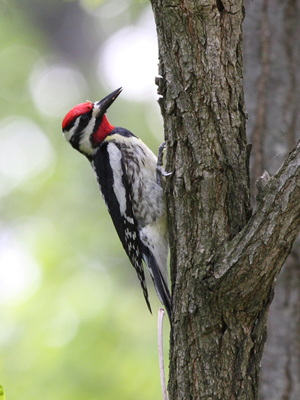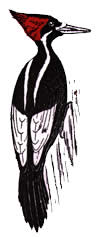CUBAN PICIFORMES - Woodpeckers, Flickers, Sapsuckers
|
|||||||||||||||||||||||||||||||||||||||
CUBAN PICIFORMES - Woodpeckers, Flickers, Sapsuckers
World Status Key |
| Species |
Sounds |
Occurrence |
| West Indian Woodpecker - Melanerpes superciliaris |
Non-breeding | |
| Audio Credit: xeno-canto.org Jon King | ||
| Yellow-bellied Sapsucker - Sphyrapicus varius |
Non-breeding | |
| Audio Credit: xeno-canto.org Jonathon Jongsma | ||
| Cuban Green Woodpecker - Xiphidiopicus percussus |
Endemic | |
| Audio Credit: xeno-canto.org Gerard Gorman | ||
| Northern Flicker - Colaptes auratus |
Year-round | |
| Audio Credit: xeno-canto.org Paul Jaszczak | ||
| Fernandina's Flicker - Colaptes fernandinae |
Endemic | |
| Audio Credit: xeno-canto.org Brian Cox | ||
| Ivory-billed Woodpecker - Campephilus principalis |
No Available Audio | Possibly Extinct |
Additional Information
Key: ![]() Profile
Profile ![]() Photos
Photos ![]() Video
Video ![]() Audio
Audio
The West Indian woodpecker is found in the Bahamas, the Cayman Islands, Cuba, and the Turks and Caicos Islands.
Source: Internet Bird Collection Intended Audience: General Reading Level: Middle School
Yellow-bellied Sapsucker - Sphyrapicus varius ![]()
![]()
![]()
![]()
![]()
![]()
![]()
The yellow-bellied sapsucker is found in North America, Central America, and the Caribbean.
Source: Arkive Intended Audience: General Reading Level: Middle School
Yellow-bellied Sapsucker - Sphyrapicus varius ![]()
![]()
![]()
![]()
![]()
![]()
![]()
In the United States, the yellow-bellied sapsucker is found in the eastern half of the country.
Source: Cornell Lab of Ornithology Intended Audience: General Reading Level: Middle School
Yellow-bellied Sapsucker - Sphyrapicus varius ![]()
![]()
![]()
![]()
![]()
![]()
The male yellow-bellied sapsucker male has a red crown, black and white head and a red throat.
The female has a white throat. Both the male and the female have a yellow breast and upper belly.
Source: Animal Diversity Web Intended Audience: General Reading Level: Middle School
Yellow-bellied Sapsucker - Sphyrapicus varius ![]()
![]()
![]()
![]()
![]()
![]()
![]()
The male yellow-bellied sapsucker feeds on sap, insects, fruit, and berries.
Source: Internet Bird Collection Intended Audience: General Reading Level: Middle School
Cuban Green Woodpecker - Xiphidiopicus percussus ![]()
![]()
![]()
![]()
![]()
The Cuban green woodpecker is found in Cuba.
Source: Internet Bird Collection Intended Audience: General Reading Level: Middle School
Northern Flicker - Colaptes auratus ![]()
![]()
![]()
![]()
![]()
![]()
The northern flicker is found in Canada, the cayman Islands, Cuba, El Salvador, Guatemala, Honduras, Mexico, Nicaragua, Saint Pierre and Miquelon, and the United States.
Source: Arkive Intended Audience: General Reading Level: Middle School
Northern Flicker - Colaptes auratus ![]()
![]()
![]()
![]()
![]()
![]()
![]()
The northern flicker is found across most of the United States.
Source: Cornell Lab of Ornithology Intended Audience: General Reading Level: Middle School
Northern Flicker - Colaptes auratus ![]()
![]()
![]()
![]()
![]()
![]()
![]()
Unlike most black and white woodpecker species in the United States, the northern flicker is a brownish-gray.
Source: Seattle Audubon BirdWeb Intended Audience: General Reading Level: Middle School
Northern Flicker - Colaptes auratus ![]()
![]()
![]()
![]()
![]()
![]()
![]()
A large part of the northern flicker's diet is made up of ants.
Source: Animal Diversity Web Intended Audience: General Reading Level: Middle School
Northern Flicker - Colaptes auratus ![]()
![]()
![]()
![]()
![]()
![]()
![]()
The northern flicker is also known as The yellowhammer.
Source: Internet Bird Collection Intended Audience: General Reading Level: Middle School
Fernandina's Flicker - Colaptes fernandinae ![]()
![]()
![]()
![]()
![]()
Fernandina's flicker is found in Cuba.
Source: Arkive Intended Audience: General Reading Level: Middle School
Fernandina's Flicker - Colaptes fernandinae ![]()
![]()
![]()
![]()
Fernandina's flicker is threatened by habitat fragmentation.
Source:BirdLife International Intended Audience: General Reading Level: High School
Fernandina's Flicker - Colaptes fernandinae ![]()
![]()
![]()
![]()
Fernandina's flicker is a small yellowish-tan bird with black-barred wings.
Source: Internet Bird Collection Intended Audience: General Reading Level: Middle School
Ivory-billed Woodpecker - Campephilus principalis ![]()
![]()
![]()
![]()
![]()
The ivory-billed woodpecker is found in Cuba.
Source: Arkive Intended Audience: General Reading Level: Middle School
Ivory-billed Woodpecker - Campephilus principalis ![]()
![]()
![]()
![]()
![]()
![]()
![]()
The ivory-billed woodpecker was once found from east Texas to North Carolina, from southern Illinois through Florida, and south to Cuba. Scientists are trying to determine if it is still in its original range.
Source: Cornell Lab of Ornithology - Ivory-billed Woodpecker Search Intended Audience: General Reading Level: Middle School
Ivory-billed Woodpecker - Campephilus principalis ![]()
![]()
![]()
![]()
![]()
![]()
The ivory-billed woodpecker is the the third largest woodpecker in the world.
Source: Cornell Lab of Ornithology Intended Audience: General Reading Level: Middle School
Ivory-billed Woodpecker - Campephilus principalis ![]()
![]()
![]()
![]()
![]()
Ivory-billed woodpeckers make a unique double-knock noise when pecking at trees.
Source: National Geographic Intended Audience: General Reading Level: Middle School
Ivory-billed Woodpecker - Campephilus principalis ![]()
![]()
![]()
![]()
![]()
Ivory-billed woodpeckers get their name from their long, sharp white bill.
Source: Animal Diversity Web Intended Audience: General Reading Level: Middle School
Ivory-billed Woodpecker - Campephilus principalis ![]()
![]()
![]()
![]()
![]()
Robert Krulwich reports on the search for the ivory-billed woodpecker.
Source: PBS NOVA ScienceNOW Intended Audience: General Reading Level: Middle School


